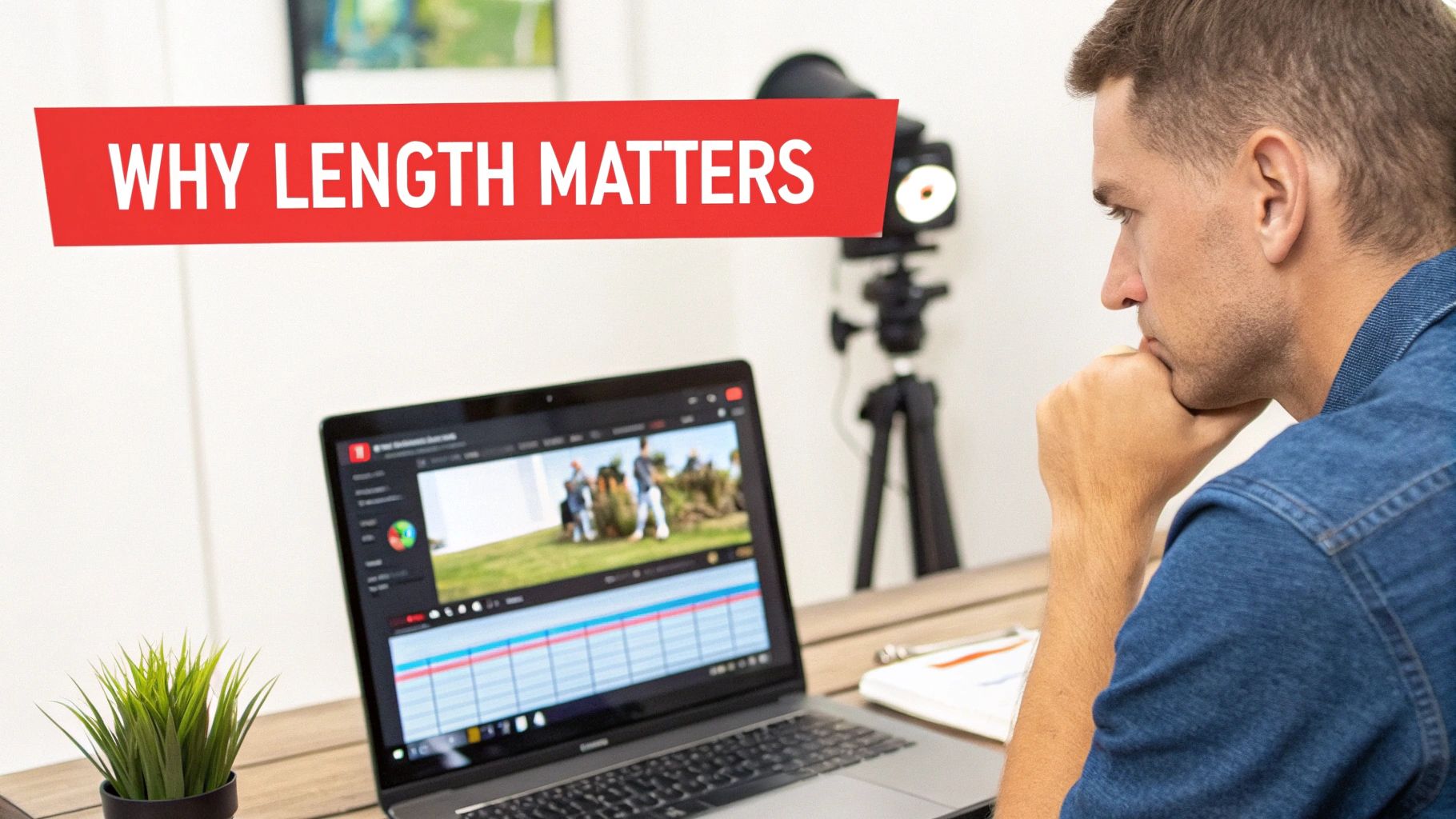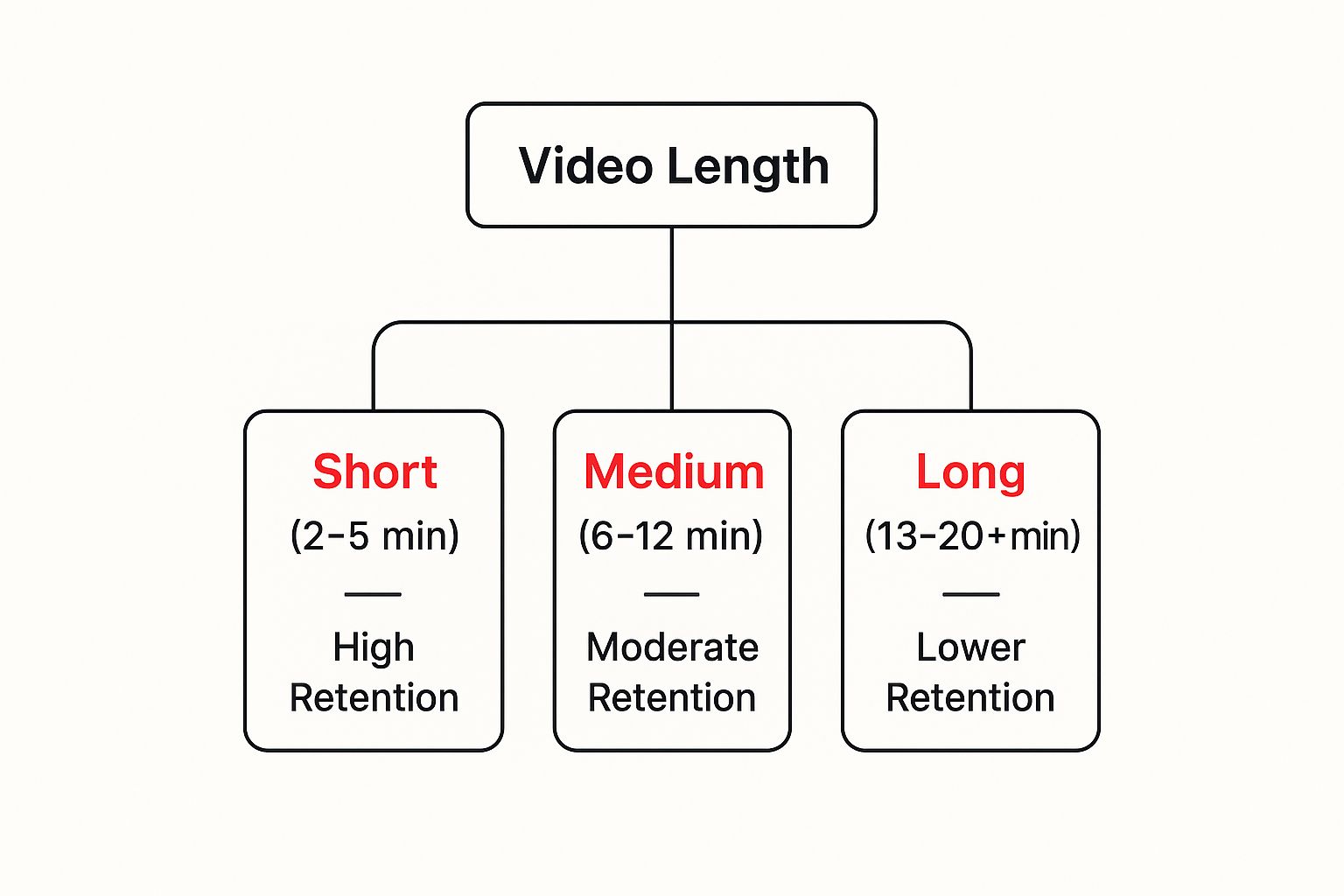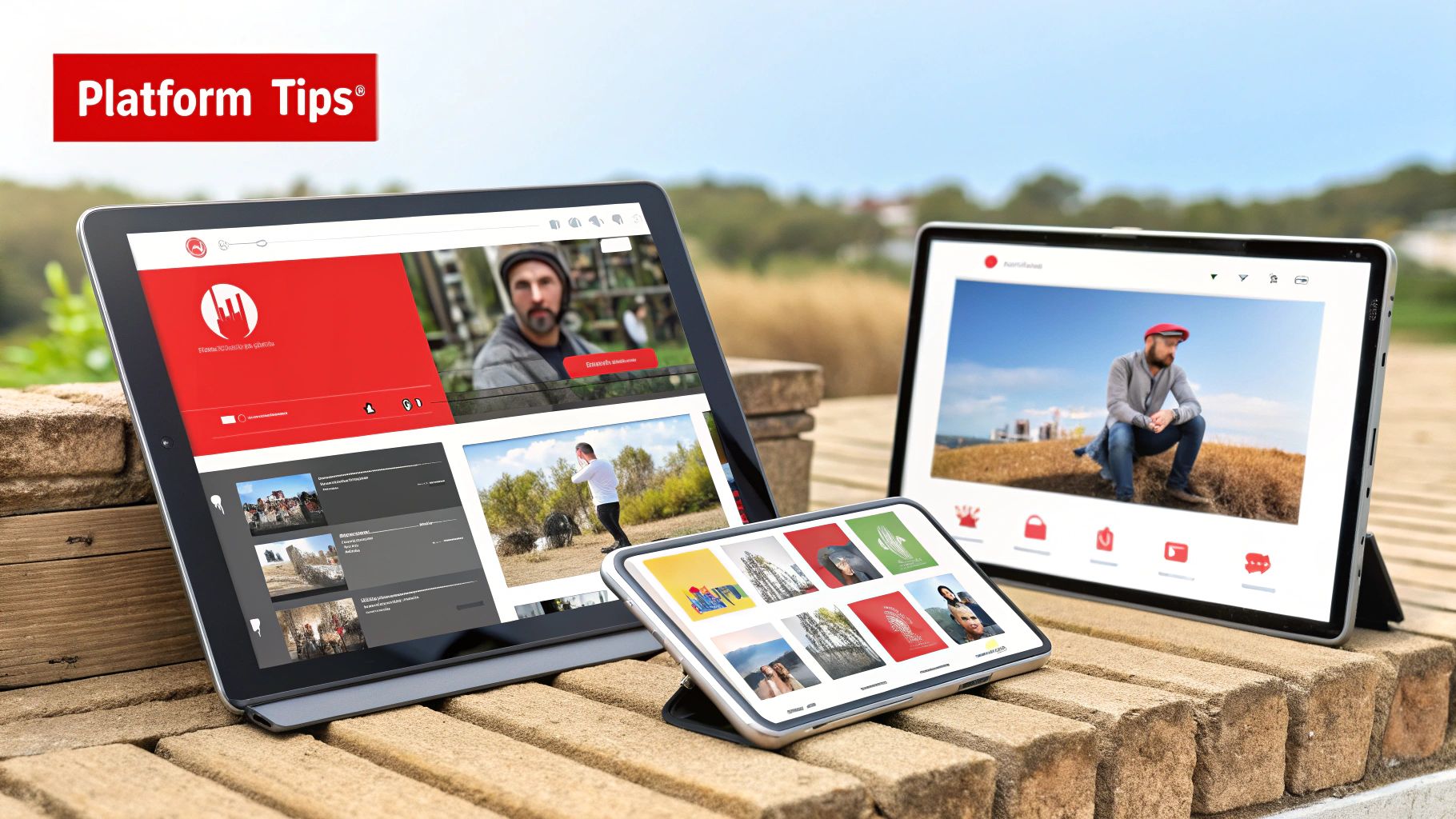So, you're trying to figure out the perfect length for your next YouTube video. It's the million-dollar question, isn't it? The truth is, there's no magic number. The best advice I can give you is this: make your video as long as it needs to be, but not a second longer.
It’s all about matching the video's length to its purpose and what your audience is actually there for.
The Real Answer to Your Video Length Question

Creators get stuck on this all the time. But thinking there's a single, perfect video duration is a trap. A video is like a good story—it needs to wrap up right after the main point hits home. Stretching it out with fluff just to hit a certain time is the fastest way to make viewers click away.
The real key is to let the goal of your video dictate its length. Are you making a quick tutorial to solve one specific problem? Keep it short and sweet. But if you're producing a deep-dive documentary or a detailed product teardown, it's naturally going to need more time to deliver real value. It’s all about respecting your viewer's time while fulfilling the promise you made in your title and thumbnail.
What the Data Says About Average Length
Even though there's no single "best" length, the data does show a pretty clear trend. The average YouTube video tends to fall somewhere between 11.7 to 12.5 minutes. This seems to be the sweet spot where videos are long enough to be monetized effectively but still short enough to keep people watching. You can check out more fascinating YouTube user statistics to see how viewing habits are evolving.
At the end of the day, your own audience will tell you what works. But before we get into the nitty-gritty strategy, here's a quick cheat sheet to get you started.
Quick Guide to YouTube Video Length by Content Type
This table breaks down some common video formats and the typical length ranges that work best for them. Think of it as a starting point, not a strict set of rules.
| Content Type | Ideal Length Range | Primary Goal |
|---|---|---|
| Tutorials & How-To's | 2-5 minutes | Quick problem-solving |
| Product Reviews | 6-10 minutes | Detailed, balanced analysis |
| Vlogs | 8-15 minutes | Storytelling & connection |
| Educational Explainers | 10-20 minutes | In-depth topic coverage |
| Commentary/Analysis | 8-18 minutes | Building authority & perspective |
Use these numbers as a guide, but always listen to your analytics and what your viewers are telling you through their watch time. That’s where the real answers are.
Why Watch Time Trumps Total Video Length

So many creators get hung up on hitting a specific runtime, thinking that a longer video is automatically better for the algorithm. It's a common trap, but it completely misses the point of what YouTube actually wants. The platform's number one goal is simple: keep people on the site for as long as possible. The single most important metric that shows you're helping them do that is Watch Time.
Think of it this way. Your YouTube channel is like a restaurant. Total views are just the number of people who walk through the door. Sure, that number matters, but it doesn't tell you if they liked the food. Watch Time, on the other hand, is like tracking how long those customers stick around, finish their meal, and maybe even order dessert. A restaurant packed with happy people who are staying for a while is obviously a great experience. High watch time sends the exact same signal to YouTube.
Before we dive deeper, it helps to know what defines a video view to begin with. Once you understand that, it's easy to see why watch time offers so much more insight into how satisfied your audience really is. YouTube rewards videos that rack up a ton of watch time because it's the clearest sign that viewers are hooked and getting value.
A 5-minute video that people watch for an average of 4 minutes (80% retention) is far more valuable to the algorithm than a 15-minute video that people only watch for 3 minutes (20% retention).
This is exactly why padding your videos with fluff just to make them longer can kill your channel's performance.
Decoding Your Audience Retention Graph
The secret to mastering watch time is already waiting for you inside your YouTube Studio analytics. The key is the Audience Retention graph. Think of this tool as your direct line into the minds of your viewers. It shows you, second by second, the exact percentage of your audience that is still watching.
This graph isn't just a boring line; it’s telling you a story about your video's pacing, its highs, and its lows. Here’s how you can learn to read it:
- A high, flat line: This is what you're aiming for. It’s the gold standard, showing you're holding your audience's attention all the way through.
- A steep drop-off at the start: A huge red flag. This usually means your intro is weak or your title and thumbnail set the wrong expectation. People clicked expecting one thing and immediately left when they got something else.
- Sudden dips: These are the moments where a chunk of your audience decided to leave. Go back and watch these timestamps in your video. Did you ramble? Was the audio bad? Did you get boring?
- Bumps or spikes: These are rare but pure gold. A bump means people are actually rewinding and re-watching a specific part. Whatever you did there, do more of it!
By actually studying this graph, you can stop guessing and start making smart, data-driven decisions about your content. You’ll see exactly what’s working and what’s not, helping you create videos that keep people watching right to the end, no matter the final runtime.
Matching Video Length to Your Content's Purpose
Alright, you get it—watch time is king. But knowing that is one thing; putting it into practice is another. The real secret isn't about arbitrarily making videos shorter or longer. It's about making sure your video's runtime is perfectly in sync with its purpose and what your audience is there to see.
Think of your video's length as a promise. When someone sees a title like "Quick 2-Minute Photoshop Tip," they expect exactly that. On the other hand, a title like "The Complete History of Ancient Rome" signals a deep-dive, and viewers are ready for a longer commitment. If you break that promise, you lose the viewer. It's that simple.
This image gives a great visual breakdown of how audience retention usually plays out across different video lengths.

As you can see, it's generally easier for short videos to keep a high retention rate. For longer content, you've got to work much harder to keep people from clicking away.
Finding the Sweet Spot for Different Video Types
Every type of video has its own natural rhythm. A product review needs enough time to feel thorough and build trust. A vlog needs room to breathe and tell a story. The first step in figuring out your ideal video length is knowing what kind of content you're actually making.
Here are some tried-and-true duration targets for popular YouTube formats:
- Tutorials and How-To Videos: People come to these for fast answers. They want a quick, straight-to-the-point solution. Aim for 2 to 5 minutes to deliver value without any fluff.
- Product Reviews: Credibility is everything. You need to show the unboxing, walk through the features, talk about what’s good and what’s not, and give your final take. A solid 6 to 12 minutes usually gives you enough runway to be genuinely helpful.
- Vlogs and Storytelling: This is all about human connection. Your length can be a bit more flexible here, but the 8 to 15-minute range is often the sweet spot. It's long enough to build a narrative but short enough to avoid rambling.
The golden rule? Make every single minute count. If a part of your video doesn't serve the core purpose or add real value, it belongs on the cutting room floor.
Educational Content and Explainers
When you're tackling complex topics, you have permission to go longer. Viewers clicking on an in-depth explainer are already prepared to invest their time to learn something substantial. For these videos, a runtime of 10 to 20 minutes is pretty standard.
But even with a longer video, structure is everything. You have to break it down with clear sections, use plenty of visuals, and keep the flow logical. This is a huge part of learning https://monetizedprofiles.com/blogs/monetization-on-social-media/how-to-create-engaging-content that people will actually stick with.
The following table provides a quick-glance guide for aligning your video format with the right duration and retention tactics.
Video Type vs Optimal Length and Engagement Strategy
| Video Type | Optimal Duration | Key to Retention | Example |
|---|---|---|---|
| Tutorials | 2-5 mins | Get to the solution fast; no long intros. | "How to Change a Tire in 3 Minutes" |
| Product Reviews | 6-12 mins | Be thorough and honest to build trust. | "iPhone 15 Pro: A 30-Day Review" |
| Vlogs | 8-15 mins | Tell a compelling story with a clear beginning, middle, and end. | "A Day in the Life of a Software Engineer" |
| Explainers | 10-20 mins | Break down complex ideas with chapters and visuals. | "Quantum Computing Explained" |
Remember, these are just starting points. Your own analytics will tell you what your specific audience responds to best.
At the end of the day, picking the right video length isn't just a technical choice; it’s a critical piece of your your video content marketing strategy playbook designed to grab your audience’s attention and keep it.
How Video Length Directly Affects Your Ad Revenue
For most creators, the dream is to turn their passion into a paycheck. Figuring out how long your YouTube videos should be isn't just about keeping viewers hooked; it's a straight line to your bank account. The length of your videos plays a huge part in how much ad revenue you can actually earn.
Think of it like a TV show. A 30-minute sitcom gets a couple of commercial breaks, but a 60-minute drama has way more. Each of those breaks is a chance to make money. YouTube is pretty similar, but it has one specific, make-or-break number that unlocks a whole new level of earning potential.
The Magic 8-Minute Mark
If there's one number you need to burn into your memory for YouTube monetization, it's eight minutes. As soon as your video crosses that threshold, you unlock the power to place mid-roll ads—commercials that can pop up in the middle of your content, not just before it starts or after it ends.
This is an absolute game-changer for your revenue. A video that clocks in at 7 minutes and 59 seconds can only have ads at the very beginning and end. But add just one more second, and a video that's 8 minutes long can have multiple ad breaks inserted throughout. This multiplies your ad inventory and, as a result, your potential earnings for that single video. For a closer look at how much earnings can differ, check out this guide on YouTube CPM by category.
Simply put, a video over eight minutes long gives you more ad slots to sell. More slots often mean more revenue, but there's a critical catch you can't ignore.
The Danger of Stretching Your Content
When creators hear about the 8-minute mark, many make a huge mistake: they start adding fluff just to hit the time. This is the fastest way to kill your channel's momentum. You have to remember that Watch Time is the metric the YouTube algorithm cares about most.
If you stretch a 5-minute idea into an 8-minute video, your audience will know. They’ll get bored and click away. That drop in audience retention sends a massive red flag to YouTube, telling the algorithm your content isn't very engaging.
What happens next? YouTube stops recommending your video, your views tank, and all those extra mid-roll ad slots become worthless because no one is sticking around long enough to see them. The real secret is to structure your content to naturally hit that 8-minute mark by packing it with genuine, can't-miss value, not by adding filler.
Using Shorts and Long-Form Videos to Grow Your Channel

A lot of creators fall into the trap of seeing YouTube Shorts and traditional long-form videos as two separate battlegrounds. But that’s the wrong way to look at it. The reality is they're two sides of the same coin, and when used together, they create a powerful growth engine for your channel.
Think of them as partners, not competitors. That mindset shift is the key to unlocking a truly effective content strategy.
Let's use an analogy. Imagine your YouTube channel is a movie studio. Your Shorts are the flashy, high-energy movie trailers. Their job is to grab attention, go viral, and introduce your brand to thousands of new people who have never heard of you before. They're fast, exciting, and built for maximum reach.
Your long-form videos? Those are the feature films. This is where the magic really happens—where you build a loyal community, establish yourself as an authority, and forge a genuine connection with your audience. These videos are what drive the bulk of your watch time and, as a result, most of your ad revenue.
The Trailer and Feature Film Strategy
The smartest channels on the platform today create a content ecosystem where Shorts and long-form videos constantly feed into each other. You use the incredible discovery potential of Shorts to pull viewers into your world, then guide them toward your deeper, more substantial content.
This symbiotic relationship is what creates sustainable, long-term growth.
Let's not forget how crowded YouTube is. The platform boasts over 2.5 billion monthly active users, with a staggering 500 hours of new content uploaded every single minute. Cutting through that noise is a monumental task. Shorts give you a unique edge. You can find more details in this breakdown of YouTube's platform statistics.
This dual-format approach lets you capture two completely different types of viewers:
- The "Scroller": This person is just browsing Shorts for a quick hit of entertainment. Your Short has just seconds to grab their attention and stop their thumb.
- The "Seeker": This user is actively searching for detailed information or in-depth entertainment. Your long-form video is exactly what they need.
By mastering both formats, you create a complete funnel. Shorts act as the wide-mouthed top, pulling in a massive audience, while your long-form videos nurture them into dedicated subscribers and fans.
How to Make Both Formats Work Together
So, how long should YouTube videos be when you're trying to balance these two formats? It all comes back to your goal. For Shorts, the answer is simple: under 60 seconds. For long-form, it's about delivering enough value to justify the runtime, just like we’ve been discussing.
Here’s a practical way to integrate them:
- Tease Your Best Stuff: Create a Short that highlights the most exciting, controversial, or valuable moment from one of your longer videos. End it with a clear call-to-action like, "Full video in my channel!"
- Repurpose Old Gold: Go back through your old long-form videos. Clip out the most compelling segments and turn them into standalone Shorts. This is a fantastic way to breathe new life into your back catalog.
- Test New Concepts: Shorts are the perfect low-risk way to test new content ideas. If a Short on a new topic gets a ton of engagement, that’s a huge green light to produce a full-length video about it.
This strategy ensures you're always providing value, whether a viewer has 30 seconds or 30 minutes to spare. And while long-form videos are still the main monetization engine, don't sleep on the earning potential of Shorts. To dive deeper, check out our complete guide on how to monetize YouTube Shorts.
We've all seen them—videos that just drag on for no good reason. It’s one of the fastest ways to lose an audience, and unfortunately, it's a trap many creators fall into. Learning from these common mistakes is the quickest way to get your own video lengths just right.
Let's start with the biggest offender: adding fluff just to hit that magic eight-minute mark for more ads. It’s tempting, I get it. But viewers have a sixth sense for filler content. The moment they feel you’re stalling, they’re gone, and your audience retention graph takes a nosedive.
Another classic mistake is the long, meandering intro. You have about 30 seconds—tops—to convince someone to stick around. If you waste that precious time with a slow-burning logo animation or a five-minute story about your morning coffee, you've already lost a huge chunk of your audience before the real content even begins.
How to Sidestep These Common Traps
The good news? These issues are surprisingly easy to fix. It all comes down to respecting your viewer's time and focusing relentlessly on delivering value.
Here’s how to correct course:
-
The Problem: Padding your video just to get more ads.
- The Fix: Don't add fluff; add value. If your topic is a solid five-minute explainer, make it the best five-minute video on the internet. If you genuinely want to make it longer, add a bonus tip, a deeper analysis, or maybe even a quick Q&A section at the end. Extend the runtime with substance, not filler.
-
The Problem: A rambling introduction that goes nowhere.
- The Fix: Get straight to the point with a powerful hook. Tell your viewers exactly what they're going to learn or what problem you'll solve for them within the first 15 seconds. Save your personal updates for a community post or a quick mention at the very end.
It really boils down to this: every single second of your video needs to justify its existence. If a clip doesn't serve the viewer or advance the topic, it needs to go. Your audience retention will thank you for it.
On the flip side, don't try to cram an encyclopedia's worth of information into a super-short video. If a topic is dense, you're far better off breaking it into a series of shorter, more focused videos. This makes the content easier to digest and gives viewers a reason to watch not just one, but multiple videos from your channel.
Frequently Asked Questions About YouTube Video Length
Alright, let's dive into some of the most common questions creators have about video length. Getting these right can make a huge difference in your strategy.
Should I Make One Long Video or a Multi-Part Series?
This is the classic creator's dilemma, and the truth is, it completely depends on your topic.
Think of it this way: if your content has clear, distinct stages or chapters, a series is almost always the way to go. It’s like the difference between a movie and a TV show. A series lets your audience process complex information in smaller, more manageable pieces. This not only makes it easier for them to learn but also encourages them to come back for the next "episode," boosting your channel's overall watch time.
But if your topic is a single, continuous story or explanation, chopping it up will just feel awkward. Viewers looking for a complete answer don't want to hunt for part two. For those kinds of videos, a single, comprehensive piece is best.
Pro Tip: Look at your audience retention graphs. If you see a massive nosedive halfway through a long video, that's your audience telling you it was too much to handle at once. That's a perfect cue to try a multi-part series for your next big topic.
How Can I Know if My Video Is Too Long Before Publishing?
You can't really judge your own work objectively. You're too close to it. The single best way to know if your video is dragging is to get a fresh pair of eyes on it.
Once you have your final cut, ask a friend or a trusted peer—someone who fits your target audience profile—to watch it.
But don't just ask, "Did you like it?" Ask them to be brutally honest. A great question is, "Was there any point where you felt bored or wanted to skip ahead?" Their feedback is pure gold. If they point to a section where you went off on a tangent or a segment that felt slow, that’s exactly where you need to start trimming.
Ready to skip the grind and start earning from day one? MonetizedProfiles offers fully approved YouTube accounts that are ready for monetization. Perfect for faceless creators and entrepreneurs, our accounts let you focus on what you do best: creating amazing content. Start your journey with a monetized channel today.









